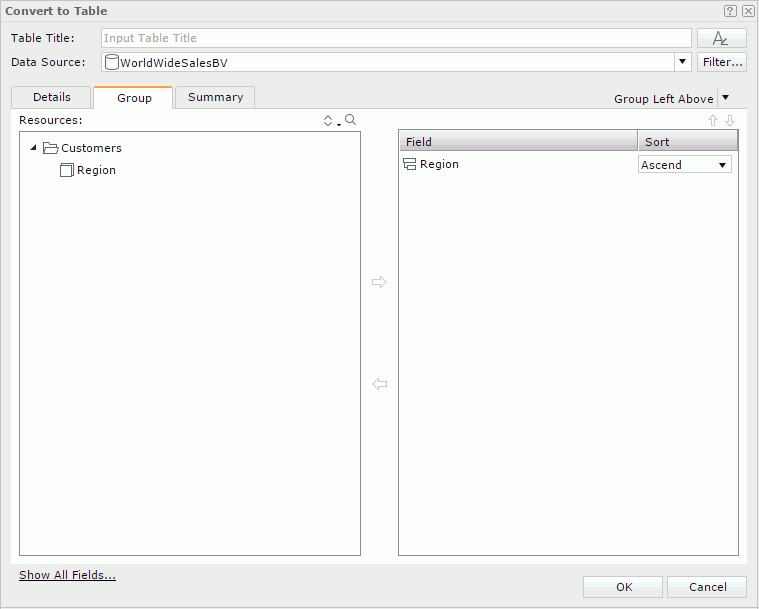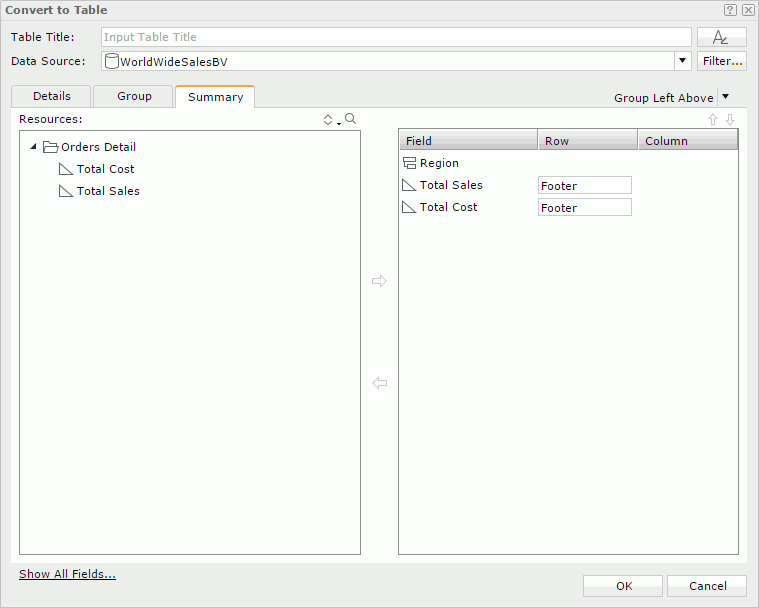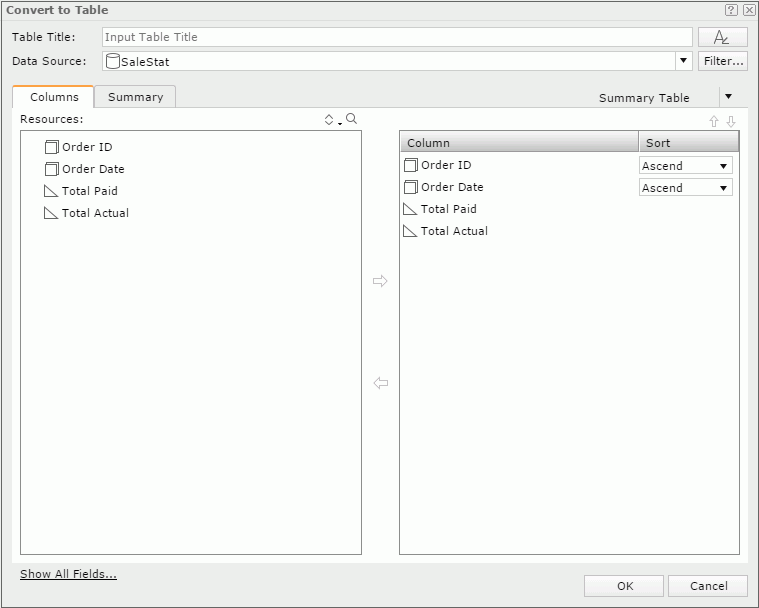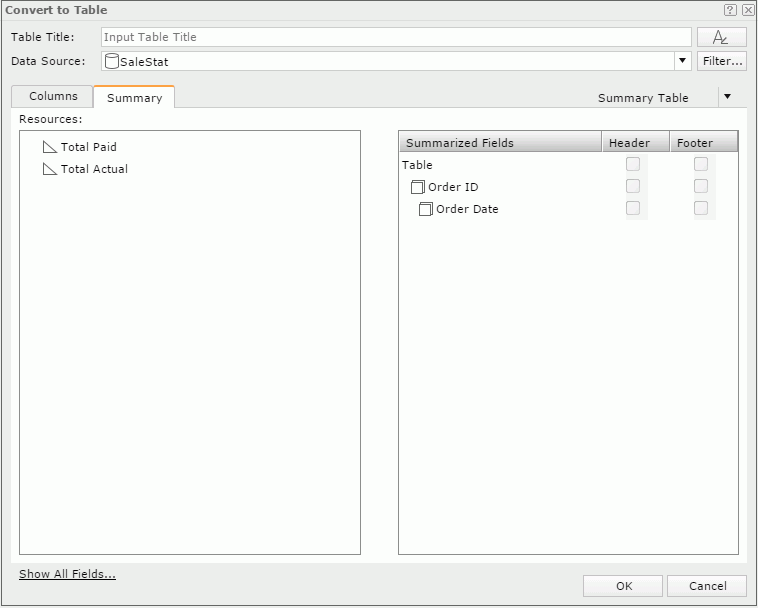Convert to Table Dialog Box Properties
This topic describes how you can use the Convert to Table dialog box to convert a table to another table. Server displays the dialog box when you focus on a table and then select the table icon  on the visualization toolbar.
on the visualization toolbar.
Table Title
Specify a title for the table.

Select the button, and Server displays the following dialog box for you to edit the font properties of the table title:

- Font
Select the font face of the title. - Font Style
Select the font style of the title: regular, bold, italic, or bold italic. - Size
Specify the font size of the title. - Align
Specify the position of the title to be left, right, center, or justify. - Font Color
Specify the font color of the title.To change the color, select the color indicator. Server displays the color palette. Select a color, or select More Colors to access the Color Picker dialog box in which you can specify a color within a wider range. You can also type a hexadecimal RGB value to specify a color, for example, #9933ff.
- Background Color
Specify the background color of the title. - OK
Select to apply any changes you made here and close the dialog box. - Cancel
Select to close the dialog box without saving any changes.
Data Source
Select a business view or dataset on which you want to build the table.
Filter
Select to open the Edit Dataset Filter dialog box to specify the filter you want to apply to the selected business view.
Table type drop-down menu
Specify the type of the table. The tabs available in the dialog box differ according to the selected table type. When you select a group table type, you can define the table in the Details, Group, and Summary tabs respectively; when you select the summary table type, only the Columns tab is available.
- Group Above
Select to create a table with group information above the detail row. - Group Left
Select to create a table with group information left to the detail row. - Group Left Above
Select to create a table with group information left above the detail row. - Summary Table
Select to create a table with only group and summary information.
Show All Fields/Show Used Fields
Select to show all the business view elements or only the ones that the current data component uses, in the Resources box. This pair of properties are not available when you select another business view to convert to table with.
OK
Select to convert to the specified table and close the dialog box.
Cancel
Select to close the dialog box without conversion.
 Help button
Help button
Select to view information about the dialog box.
 Close button
Close button
Select to close the dialog box without conversion.
The tabs in the dialog box are different according to the following table types:
For Group Left, Group Above, and Group Left Above
The dialog box consists of the following tabs: Details, Group, and Summary.
Details
Specify the detail fields that you want to display in the table.

Resources
Server displays all the group and detail objects in the selected business view or dataset.
 Sort button
Sort button
Select an order for sorting the resources in the business view. The order applies to all the resource trees where you see the business view in Web Report Studio.
The order can be one of the following:
- Predefined Order
Select if you want to sort the resources in the order as in the Business View Editor of Designer. - Resource Types
Select if you want to sort the resources by the resource type. Namely, category objects come first, then group objects, then aggregation objects, and at last detail objects. - Alphabetical Order
Select if you want to sort the resources in alphabetical order. Report sorts the resources that are not in any category first, and then the categories. It also sorts the resources in each category alphabetically.
Select to launch the search bar to search for view elements.
See the following properties in the search bar:

- Text box
Type the text you want to search in the text box. Server lists the values that contain the matched text.  Close button
Close button
Select to close the search bar.-
 More Options button
More Options button
Select the button and Server displays more search options.- Highlight All
Select if you want to highlight all matched text. - Match Case
Select if you want to search for text that meets the case of the typed text. - Match Whole Word
Select if you want to search for text that looks the same as the typed text.
- Highlight All
-
 Previous button
Previous button
Select to go to the previous matched text when you have selected Highlight All. -
 Next button
Next button
Select to go to the next matched text when you have selected Highlight All.
 Add button
Add button
Select to add the selected object to display in the table.
 Remove button
Remove button
Select to remove the selected object you added.
Field
Server lists the objects that you have added to the table as the detail fields.
Label
Specify the text for the labels of the detail columns, which by default are the display names of the added objects. You can select a text box to edit the label, or select the Auto Map Field Name checkbox beside the text box to automatically map the label to the dynamic display name of the object.
 Move Up button
Move Up button
Select to move the selected item higher in the list.
 Move Down button
Move Down button
Select to move the selected item lower in the list.
Sort Field By
Select to open the Custom Sort dialog box to specify how to sort data in the table.
Group
Specify the fields to group the data.

Resources
Server displays all the available group objects  you can use to group the data in the table.
you can use to group the data in the table.
 Sort button
Sort button
Select an order for sorting the group objects.
 Search button
Search button
Select to launch the search bar to search for view elements.
 Add button
Add button
Select to add the selected group object as a group field.
 Remove button
Remove button
Select to remove the selected group object.
Field
Server lists all the group objects that you have added as the group fields.
Sort
Specify the sort order for groups at the specific group level.
- No Sort
Select to sort a group in the same order as in the catalog. - Ascend
Select to sort a group in an ascending order. - Descend
Select to sort a group in a descending order. - Custom Sort
Select to open the Custom Sort dialog box to sort a group by sorting the values of other fields.
 Move Up button
Move Up button
Select to move the selected item higher in the list.
 Move Down button
Move Down button
Select to move the selected item lower in the list.
Summary
Specify the fields on which you want to create summaries.

Resources
Server displays all the available aggregation objects  you can use to create summaries in the table.
you can use to create summaries in the table.
 Sort button
Sort button
Select an order for sorting the aggregation objects.
 Search button
Search button
Select to launch the search bar to search for view elements.
 Add button
Add button
Select to add the selected aggregation object as the summary field.
 Remove button
Remove button
Select to remove the selected aggregation object.
Field
Server lists the groups that you have added in the table and the aggregation objects you added to summarize data in each group.
Row
Specify to put the summary field in the header or footer row. If you want to calculate the summary on a group-by field, put it in the group header or footer of the corresponding group; To calculate the summary on the table, put it in the table header or footer. The Row column is available only when the table is Group Left type.
Column
Specify to put the summary field in the specified detail column. If you select no column, Server will display the summary field in a separate summary column. The Column column is available only when the table is Group Left type.
 Move Up button
Move Up button
Select to move the selected item higher in the list.
 Move Down button
Move Down button
Select to move the selected item lower in the list.
For Summary Table
The dialog box consists of the following tabs: Columns and Summary.
Columns
Specify the fields to be the columns of the table.

Resources
Server displays all the available group and aggregation objects.
 Sort button
Sort button
Select an order for sorting the view elements.
 Search button
Search button
Select to launch the search bar to search for view elements.
 Add button
Add button
Select to add the selected object to display in the table.
 Remove button
Remove button
Select to remove the selected object you added.
Column
Server lists the objects that you have added to the table.
Sort
Specify the sort order for groups at the specific group level.
- No Sort
Select to sort a group in the same order as in the catalog. - Ascend
Select to sort a group in an ascending order. - Descend
Select to sort a group in a descending order. - Custom Sort
Select to open the Custom Sort dialog box to sort a group by sorting the values of other fields.
 Move Up button
Move Up button
Select to move the selected item higher in the list.
 Move Down button
Move Down button
Select to move the selected item lower in the list.
Summary
Specify to insert aggregations to the header/footer rows of the table and groups.

Resources
Server displays the aggregations you selected in the Columns tab.
Summarized Fields
Server displays the group fields you selected in the Columns tab under the Table node.
Header
The table header or the group header of a specific group. After selecting an aggregation in the Resources box, you can select the checkboxes in the column to insert the aggregation in the corresponding header rows.
Footer
The table footer or the group footer of a specific group. After selecting an aggregation in the Resources box, you can select the checkboxes in the column to insert the aggregation in the corresponding footer rows.
 Previous Topic
Previous Topic
 Back to top
Back to top